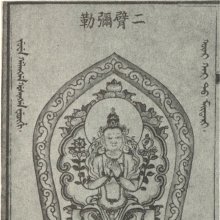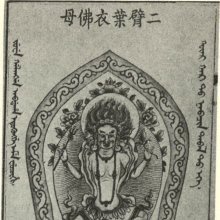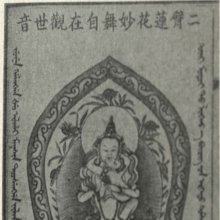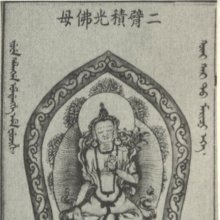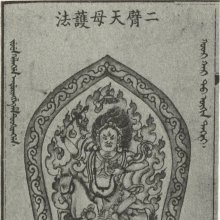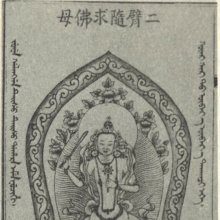Dvibhuja, Dvi-bhuja, Dvibhujā: 10 definitions
Introduction:
Dvibhuja means something in Buddhism, Pali, Hinduism, Sanskrit. If you want to know the exact meaning, history, etymology or English translation of this term then check out the descriptions on this page. Add your comment or reference to a book if you want to contribute to this summary article.
Images (photo gallery)
(+5 more images available)
In Hinduism
Shilpashastra (iconography)
Source: Archaeological Survey of India: Śaiva monuments at Paṭṭadakal (śilpa)Dvibhuja (द्विभुज) is found as a sculpture on the exterior (western wall) of the temple of Trailokyeśvara.—In this image the deity stands in samapāda holding probably a snake in his right hand and the left is in kaṭi. He is jaṭāmukuṭin. Above the niche are two flying gandharva carrying offerings to god. They are in typical Calukyan style. Above these images are small figures and effigies of temples etc. They are too small to be explained here.
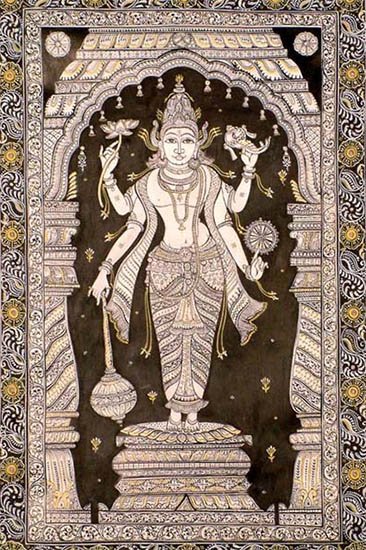
Shilpashastra (शिल्पशास्त्र, śilpaśāstra) represents the ancient Indian science (shastra) of creative arts (shilpa) such as sculpture, iconography and painting. Closely related to Vastushastra (architecture), they often share the same literature.
Shaktism (Shakta philosophy)
Source: Google Books: Manthanabhairavatantram1) Dvibhujā (द्विभुजा) refers to “she who has two arms” and is used to described the Goddess (i.e., Khageśī), according to the second recension of the Yogakhaṇḍa of the Manthānabhairavatantra, a vast sprawling work that belongs to a corpus of Tantric texts concerned with the worship of the goddess Kubjikā.—Accordingly, “In the meantime, once the goddess had crossed over the most excellent Yoga and once the fifth night had passed, she emerged from the middle of the Liṅga. [...] She (also has other forms with) two or six arms [i.e., dvibhujā] and, beautiful, sits on five ghosts. In the left hand (she holds) a skull and (in her other) upraised hands (she holds a) noose and spear. Crooked, her body grey, she is Cāmuṇḍā, the accomplished Yoginī. This Vidyā, of many forms, is the woman who resides within the Triangle. Such is the visualized form of the goddess, the deity called Khageśī”.
2) Dvibhujā (द्विभुजा) (“she who has two arms”) is also used to describe (a) Bhadrakālī or (b) Pūrṇāmaṅgalā, according to the Manthānabhairavatantra.

Shakta (शाक्त, śākta) or Shaktism (śāktism) represents a tradition of Hinduism where the Goddess (Devi) is revered and worshipped. Shakta literature includes a range of scriptures, including various Agamas and Tantras, although its roots may be traced back to the Vedas.
Shaivism (Shaiva philosophy)
Source: SOAS University of London: Protective Rites in the Netra Tantra1) Dvibhujā (द्विभुजा) refers to “she who has two arms”, according to the Netratantra of Kṣemarāja: a Śaiva text from the 9th century in which Śiva (Bhairava) teaches Pārvatī topics such as metaphysics, cosmology, and soteriology.—Accordingly, [verse 11.1-24ab, while describing the appearance and worship of Tumburu]—“[...] However, those who are Dūtīs bear a form adorned with one face, two arms (dvibhujā), and three eyes. Adorning [them is] hair, shorn with scissors. They sit on a fish, a turtle, a makara, and a frog. The servants are two-armed and hold a sword and a hide, [faces bent] in a crooked frown [on their] single faces, [which is adorned with] three eyes. [When] meditated on, [they] burst forth with white, etc., colors, giving the fruits of siddhis. [...]”.
2) Dvibhuja (द्विभुज) or “two-armed” is also used to describe Viśvakarman.—Accordingly, [verse 13.25cd-28, while describing the appearance and worship of Viśvakarman]—“Furthermore, [I shall describe] Viśvakarman, the Lord of the world. [He] is bright as a ray of light, risen alone [i.e., from itself]. [Viśvakarman] has [either] two (dvibhuja) or four arms. [When he has four hands he] bears a stone cutter’s chisel and a book with [his] beautiful right hand. [In the left he holds] a clamp and a cord. [...]”.

Shaiva (शैव, śaiva) or Shaivism (śaivism) represents a tradition of Hinduism worshiping Shiva as the supreme being. Closely related to Shaktism, Shaiva literature includes a range of scriptures, including Tantras, while the root of this tradition may be traced back to the ancient Vedas.
In Buddhism
Tibetan Buddhism (Vajrayana or tantric Buddhism)
Source: OSU Press: Cakrasamvara SamadhiDvibhuja (द्विभुज) refers to “having two arms” and is used to describe Śrī Vajrasattva, according to the Guru Mandala Worship (maṇḍalārcana) ritual often performed in combination with the Cakrasaṃvara Samādhi, which refers to the primary pūjā and sādhanā practice of Newah Mahāyāna-Vajrayāna Buddhists in Nepal.—Accordingly, “Oṃ in the middle of mantra inhabited ground, arisen of the four seeds, yaṃ, etc., a maṇḍala of the great elements, wind, fire, water, and earth, Above that, (arising from) the letter suṃ, is the merumaṇḍala, Above that, on a jeweled lion-throne, lotus, and a lunar-disc, Śrī Vajrasattva, two arms (dvibhuja), one face, white color, Holding a vajra (and) vajra-bell, (and) adorned wearing various colors, Bearing a monk’s headdress, (and) a sapphire Akṣobhya adorned crown, Thus imagine the worshipful guru[...]”.

Tibetan Buddhism includes schools such as Nyingma, Kadampa, Kagyu and Gelug. Their primary canon of literature is divided in two broad categories: The Kangyur, which consists of Buddha’s words, and the Tengyur, which includes commentaries from various sources. Esotericism and tantra techniques (vajrayāna) are collected indepently.
Languages of India and abroad
Sanskrit dictionary
Source: DDSA: The practical Sanskrit-English dictionaryDvibhuja (द्विभुज).—an angle.
Derivable forms: dvibhujaḥ (द्विभुजः).
Dvibhuja is a Sanskrit compound consisting of the terms dvi and bhuja (भुज).
Source: Cologne Digital Sanskrit Dictionaries: Shabda-Sagara Sanskrit-English DictionaryDvibhuja (द्विभुज).—mfn.
(-jaḥ-jā-jaṃ) 1. Two armed. 2. An angle or the lines which form it. E. dvi two, and bhuja an arm.
Source: Cologne Digital Sanskrit Dictionaries: Cappeller Sanskrit-English DictionaryDvibhuja (द्विभुज).—[adjective] = dvibāhu.
Source: Cologne Digital Sanskrit Dictionaries: Monier-Williams Sanskrit-English Dictionary1) Dvibhuja (द्विभुज):—[=dvi-bhuja] [from dvi] mfn. ‘2-armed’ [Hemādri’s Caturvarga-cintāmaṇi]
2) [v.s. ...] n. an angle, [Horace H. Wilson]
Source: Cologne Digital Sanskrit Dictionaries: Yates Sanskrit-English DictionaryDvibhuja (द्विभुज):—[dvi-bhuja] (jaḥ-jā-jaṃ) a. Idem.
[Sanskrit to German]
Sanskrit, also spelled संस्कृतम् (saṃskṛtam), is an ancient language of India commonly seen as the grandmother of the Indo-European language family (even English!). Closely allied with Prakrit and Pali, Sanskrit is more exhaustive in both grammar and terms and has the most extensive collection of literature in the world, greatly surpassing its sister-languages Greek and Latin.
See also (Relevant definitions)
Starts with: Dvibhujaramadhyana.
Ends with: Samadvibhuja, Samadvidvibhuja.
Full-text: Samadvibhuja, Dvibhujaramadhyana, Samadvidvibhuja, Ekamukha, Saptakshara.
Relevant text
Search found 10 books and stories containing Dvibhuja, Dvi-bhuja, Dvibhujā, Dvi-bhujā; (plurals include: Dvibhujas, bhujas, Dvibhujās, bhujās). You can also click to the full overview containing English textual excerpts. Below are direct links for the most relevant articles:
Garga Samhita (English) (by Danavir Goswami)
Verse 4.19.91 < [Chapter 19 - A Thousand Names of Srī Yamunā]
Chaitanya Bhagavata (by Bhumipati Dāsa)
Verse 1.12.160 < [Chapter 12 - The Lord’s Wandering Throughout Navadvīpa]
Bhakti-rasamrta-sindhu (by Śrīla Rūpa Gosvāmī)
Verse 3.2.7 < [Part 2 - Affection and Service (dāsya-rasa)]
Shrimad Bhagavad-gita (by Narayana Gosvami)
Verse 11.51 < [Chapter 11 - Viśvarūpa-darśana-yoga (beholding the Lord’s Universal Form)]
Prasthanatrayi Swaminarayan Bhashyam (Study) (by Sadhu Gyanananddas)
4.3.3. Akṣarabrahman as Sevaka in Akṣaradhāma < [Chapter 3 - Analysis on the Basis of Metaphysics]
5.4.2. Parabrahman in Human-Like Form < [Chapter 3 - Analysis on the Basis of Metaphysics]
Vishnudharmottara Purana (Art and Architecture) (by Bhagyashree Sarma)
8(b): The Image of Various Gods < [Chapter 5 - Painting and Image Making]
Related products
